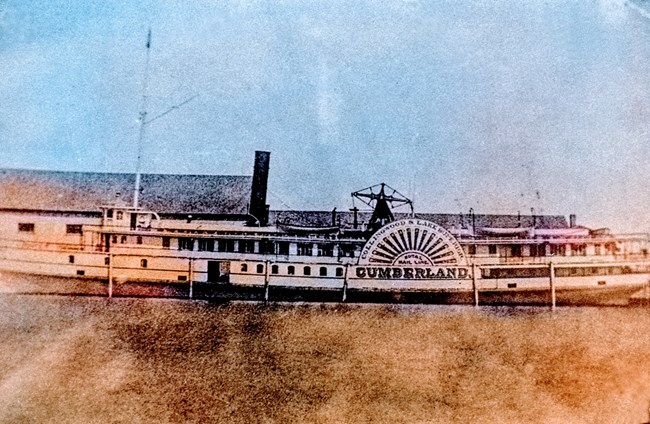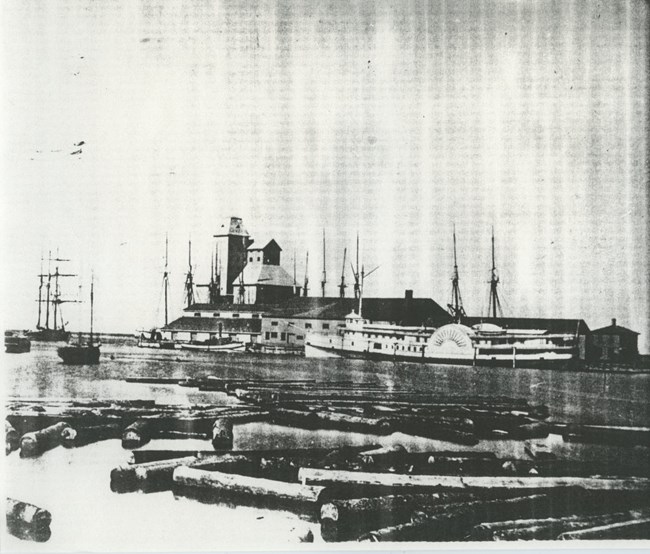Last updated: September 24, 2020
Article
SS Cumberland: Operational History

Isle Royale National Park Archives
Operational History
Cumberland's first full season of navigation was 1872, a year that initiated a series of incidents that were to afflict the steamer throughout its relatively short history of operation. Cumberland carried about 600 passengers and a heavy load of freight, horses and cattle on its first 1872 trip (Toronto Mail, May 11, 1872; Meaford Monitor, May 16, 1872).
September 1872 was a stormy month, and some vessels were lost. The schooner Maple Leaf was swamped near Isle Royale and eventually capsized in rough weather. The captain and crew were able to abandon ship and were taken to Silver Islet. During the wreck, the captain reported he had sighted Cumberland, but it was not able to render assistance due to the heavy seas ( Meaford Monitor, Oct. 17, 1872).
In November of 1872, Cumberland was frozen in the ice in Bear Lake in the St. Mary's River. Captain Orr, the chief engineer and four of the crew arrived on foot in Collingwood on December 27. Several days after them, 18 of the crew arrived after making the 20-day trek down the north shore of Georgian Bay. According to their reports, they suffered terrible weather and privation on their journey; all were frostbitten. Captain Orr had left Cumberland in the charge of the first mate, with the steward, stewardess and two waiters left on board (Toronto Mail, Dec. 27, 28, 1872; Marquette Daily Mining Journal, January 4, 1873). There were also 50 passengers aboard (Toronto Mail, Dec. 11, 1872).

Great Lakes Maritime Collection, Alpena County George N. Fletcher Public Library, 40702_175765_F
In early November 1874, nearly on the anniversary of being frozen in the ice, Cumberland was caught in a storm between Sault Ste. Marie and Prince Arthur's Landing (renamed Port Arthur in 1884) and very nearly wrecked. Cumberland may have been near Passage Island when it was caught (Meaford Monitor, Nov. 10, 1874).
The caulking came out of the hold planks in several places and the ship began leaking badly. To keep from sinking, either 75 (Duluth Minnesotian, Nov. 7, 1874) or 150 (Ashland Press, Nov. 14, 1874) head of cattle and some freight were thrown overboard. It was reported that $3,000 worth of cattle, sheep and hogs belonging to Brown Bros, and all the deck cargo were dumped overboard (Meaford Monitor, Nov. 10, 1874). Cumberland arrived at Prince Arthur's Landing with 6 feet of water in the hold, and promptly sank (Duluth Minnesotian, Nov. 7, 1874; Ashland Press, Nov. 14, 1874).
The November 1875 newspapers reported Cumberland was ashore and scuttled. The vessel was again caught in a late season storm and went ashore three miles from Silver Islet at Lee or T Harbor in a blinding snowstorm, with gale-force winds from the east (The Daily Globe, Nov. 3, 1875; Cleveland Herald, Nov. 5, 1875). There was little damage, and the steamer, with passengers and freight intact, arrived in Thunder Bay November 4, after being pulled free by tugs (Cleveland Herald, Nov. 8, 1875; The Daily Globe, Nov. 5, 1875). The freight carried by Cumberland included "copper ore, fish, and fourteen span of horses, and about 100 passengers" (Chicago Inter Ocean, Nov. 8, 1875).
On Sept. 15, 1876 Cumberland ran aground at Owen Sound. While trying to get the vessel off by using a line wrapped on the shaft of the wheel, Capt. Orr was injured. The line snapped and broke both of the captain's legs. Captain Parsons took the command for the trip (Duluth Minnesotian, Sept. 23, 1876).
